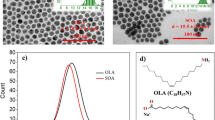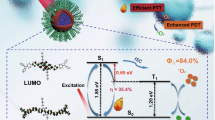Abstract
A nanoassembly of PEI-passivated Gd@CDs, a type of aptamer, is presented which was designed and characterized in order to target specific cancer cells based on their recognition of the receptor nucleolin (NCL), which is overexpressed on the cell membrane of breast cancer cells for fluorescence and magnetic resonance imaging and treatment. Using hydrothermal methods, Gd-doped nanostructures were synthesized, then modified by a two-step chemical procedure for subsequent applications: the passivating of Gd@CDs with branched polyethyleneimine (PEI) (to form Gd@CDs-PEI1 and Gd@CDs-PEI2), and using AS1411 aptamer (AS) as a DNA-targeted molecule (to generate AS/Gd@CDs-PEI1 and AS/Gd@CDs-PEI2). Consequently, these nanoassemblies were constructed as a result of electrostatic interactions between cationic Gd@CDs-passivated PEI and AS aptamers, offering efficient multimodal targeting nanoassemblies for cancer cell detection. It has been demonstrated through in vitro studies that both types of AS-conjugated nanoassemblies are highly biocompatible, have high cellular uptake efficiency (equivalent concentration of AS: 0.25 μΜ), and enable targeted fluorescence imaging in nucleolin-positive MCF7 and MDA-MB-231 cancer cells compared to MCF10-A normal cells. Importantly, the as-prepared Gd@CDs, Gd@CDs-PEI1, and Gd@CDs-PEI2 exhibit higher longitudinal relaxivity values (r1) compared with the commercial Gd-DTPA, equal to 5.212, 7.488, and 5.667 mM−1s−1, respectively. Accordingly, it is concluded that the prepared nanoassemblies have the potential to become excellent candidates for cancer targeting and fluorescence/MR imaging agents, which can be applied to cancer imaging and personalized nanomedicine.
Graphical Abstract







Similar content being viewed by others
Data availability
Data will be made available on request.
References
Rosenkrans ZT, Ferreira CA, Ni D, Cai W (2021) Internally responsive nanomaterials for activatable multimodal imaging of cancer. Adv Healthc Mater 10:2000690. https://doi.org/10.1002/adhm.202000690
Cao Y, Xu L, Kuang Y et al (2017) Gadolinium-based nanoscale MRI contrast agents for tumor imaging. J Mater Chem B 5:3431–3461. https://doi.org/10.1039/c7tb00382j
Zylke JW (2020) Erratum: Comparison of abbreviated breast MRI vs digital breast tomosynthesis for breast cancer detection among women with dense breasts undergoing screening. JAMA 323(8):746–756. https://doi.org/10.1001/jama.2020.2991
Walia S, Chandrasekaran AR, Chakraborty B, Bhatia D (2021) Aptamer-programmed DNA nanodevices for advanced, targeted cancer theranostics. ACS Appl Bio Mater 2:5392–5404. https://doi.org/10.1021/acsabm.1c00413
Chen T, Ren L, Liu X et al (2018) DNA nanotechnology for cancer diagnosis and therapy. Int J Mol Sci 19:1671. https://doi.org/10.3390/ijms19061671
Ravichandran G, Rengan AK (2020) Aptamer-mediated nanotheranostics for cancer treatment: a review. ACS Appl Nano Mater 3:9542–9559. https://doi.org/10.1021/acsanm.0c01785
Lin M, Zhang J, Wan H et al (2021) Rationally designed multivalent aptamers targeting cell surface for biomedical applications. ACS Appl Mater Interfaces 13:9369–9389. https://doi.org/10.1021/acsami.0c15644
Kaur H, Bruno JG, Kumar A, Sharma TK (2018) Aptamers in the therapeutics and diagnostics pipelines. Theranostics 8:4016–4032. https://doi.org/10.7150/thno.25958
Geng Z, Cao Z, Liu R et al (2021) Aptamer-assisted tumor localization of bacteria for enhanced biotherapy. Nat Commun 12:1–12. https://doi.org/10.1038/s41467-021-26956-8
He S, Gao F, Ma J et al (2021) Aptamer-PROTAC conjugates (APCs) for tumor-specific targeting in breast cancer. Chemie - Int Ed 60:23299–23305. https://doi.org/10.1002/anie.202107347
Gregório AC, Lacerda M, Figueiredo P et al (2018) Meeting the needs of breast cancer: a nucleolin’s perspective. Crit Rev Oncol Hematol 125:89–101. https://doi.org/10.1016/j.critrevonc.2018.03.008
Pichiorri F, Palmieri D, De Luca L et al (2013) In vivo NCL targeting affects breast cancer aggressiveness through miRNA regulation. J Exp Med 210:951–968. https://doi.org/10.1084/jem.20120950
Dam DHM, Culver KSB, Odom TW (2014) Grafting aptamers onto gold nanostars increases in vitro efficacy in a wide range of cancer cell types. Mol Pharm 11:580–587. https://doi.org/10.1021/mp4005657
Mehrnia SS, Hashemi B, Mowla SJ et al (2021) Radiosensitization of breast cancer cells using AS1411 aptamer-conjugated gold nanoparticles. Radiat Oncol 16:1–12. https://doi.org/10.1186/s13014-021-01751-3
Li S, Jiang Q, Liu S et al (2018) A DNA nanorobot functions as a cancer therapeutic in response to a molecular trigger in vivo. Nat Biotechnol 36:258–264. https://doi.org/10.1038/nbt.4071
Shen CL, Lou Q, Liu KK et al (2020) Chemiluminescent carbon dots: synthesis, properties, and applications. Nano Today 35:100954. https://doi.org/10.1016/j.nantod.2020.100954
Li M, Chen T, Gooding JJ, Liu J (2019) Review of carbon and graphene quantum dots for sensing. ACS Sensors 4:1732–1748. https://doi.org/10.1021/acssensors.9b00514
Park Y, Yoo J, Lim B et al (2016) Improving the functionality of carbon nanodots: Doping and surface functionalization. J Mater Chem A 4:11582–11603. https://doi.org/10.1039/c6ta04813g
Pirsaheb M, Mohammadi S, Salimi A (2019) Current advances of carbon dots based biosensors for tumor marker detection, cancer cells analysis and bioimaging. TrAC - Trends Anal Chem 115:83–99. https://doi.org/10.1016/j.trac.2019.04.003
Kim S, Choi Y, Park G et al (2017) Highly efficient gene silencing and bioimaging based on fluorescent carbon dots in vitro and in vivo. Nano Res 10:503–519. https://doi.org/10.1007/s12274-016-1309-1
Sciortino L, Sciortino A, Popescu R et al (2018) Tailoring the emission color of carbon dots through nitrogen-induced changes of their crystalline structure. J Phys Chem C 122:19897–19903. https://doi.org/10.1021/acs.jpcc.8b04514
Hua XW, Bao YW, Wu FG (2018) Fluorescent carbon quantum dots with intrinsic nucleolus-targeting capability for nucleolus imaging and enhanced cytosolic and nuclear drug delivery. ACS Appl Mater Interfaces 10:10664–10677. https://doi.org/10.1021/acsami.7b19549
Corr SA, Byrne SJ, Tekoriute R et al (2008) Linear assemblies of magnetic nanoparticles as MRI contrast agents. J Am Chem Soc 130:4214–4215. https://doi.org/10.1021/ja710172z
Hou X, Hu Y, Wang P et al (2017) Modified facile synthesis for quantitatively fluorescent carbon dots. Carbon N Y 122:389–394. https://doi.org/10.1016/j.carbon.2017.06.093
Li T, Murphy S, Kiselev B et al (2015) A new interleukin-13 amino-coated gadolinium metallofullerene nanoparticle for targeted MRI detection of glioblastoma tumor cells. J Am Chem Soc 137:7881–7888. https://doi.org/10.1021/jacs.5b03991
Du F, Zhang M, Gong A et al (2017) Engineered gadolinium-doped carbon dots for magnetic resonance imaging-guided radiotherapy of tumors. Biomaterials 121:109–120. https://doi.org/10.1016/j.biomaterials.2016.07.008
Gao A, Kang YF, Yin XB (2017) Red fluorescence-magnetic resonance dual modality imaging applications of gadolinium containing carbon quantum dots with excitation independent emission. New J Chem 41:3422–3431. https://doi.org/10.1039/c7nj00597k
Sun YP, Zhou B, Lin Y et al (2006) Quantum-sized carbon dots for bright and colorful photoluminescence. J Am Chem Soc 128:7756–7757. https://doi.org/10.1021/ja062677d
Sarrami P, Karbasi S, Farahbakhsh Z, Bigham A, Rafienia M (2022) Fabrication and characterization of novel polyhydroxybutyrate-keratin/nanohydroxyapatite electrospun fibers for bone tissue engineering applications. Int J Biol Macromol 220:1368–1389. https://doi.org/10.1016/j.ijbiomac.2022.09.117
Han Z, Wu X, Roelle S et al (2017) Targeted gadofullerene for sensitive magnetic resonance imaging and risk-stratification of breast cancer. Nat Commun 137:7881–7888. https://doi.org/10.1038/s41467-017-00741-y
Kong T, Zhou R, Zhang Y et al (2020) AS1411 aptamer modified carbon dots via polyethylenimine-assisted strategy for efficient targeted cancer cell imaging. Cell Prolif 53:1–9. https://doi.org/10.1111/cpr.12713
Jiao M, Wang Y, Wang W et al (2022) Gadolinium doped red-emissive carbon dots as targeted theranostic agents for fluorescence and MR imaging guided cancer phototherapy. Chem Eng J 440:135965. https://doi.org/10.1016/j.cej.2022.135965
Liu D, Jin F, Shu G et al (2019) Enhanced efficiency of mitochondria-targeted peptide SS-31 for acute kidney injury by pH-responsive and AKI-kidney targeted nanopolyplexes. Biomaterials 211:57–76. https://doi.org/10.1016/j.biomaterials.2019.04.034
Caravan P, Ellison JJ, McMurry TJ, Lauffer RB (1999) Gadolinium (III) chelates as MRI contrast agents: structure, dynamics, and applications. Chem Rev 99:2293–2352
Liu X, Mo Y, Liu X et al (2016) Synthesis, characterisation and preliminary investigation of the haemocompatibility of polyethyleneimine-grafted carboxymethyl chitosan for gene delivery. Mater Sci Eng C 62:173–182. https://doi.org/10.1016/j.msec.2016.01.050
He J, Peng T, Peng Y et al (2020) Molecularly engineering triptolide with aptamers for high specificity and cytotoxicity for triple-negative breast cancer. J Am Chem Soc 142:2699–2703. https://doi.org/10.1021/jacs.9b10510
Mansouri N, Jalal R, Akhlaghinia B et al (2020) Design and synthesis of aptamer AS1411-conjugated EG@TiO2@Fe2O3nanoparticles as a drug delivery platform for tumor-targeted therapy. New J Chem 44:15871–15886. https://doi.org/10.1039/c9nj06445a
Qi L, Gao X (2008) Quantum dot - amphipol nanocomplex for intracellular delivery and real-time imaging of siRNA. ACS Nano 2:1403–1410. https://doi.org/10.1021/nn800280r
Cheng M, Cui YX, Wang J, Zhang J, Zhu LN, Kong DM (2019) G-quadruplex/porphyrin composite photosensitizer: a facile way to promote absorption redshift and photodynamic therapy efficacy. ACS Appl Mater Interfaces 11:13158–13167
Reyes-Reyes EM, Teng Y, Bates PJ (2010) A new paradigm for aptamer therapeutic AS1411 action: uptake by macropinocytosis and its stimulation by a nucleolin-dependent mechanism role of macropinocytosis in AS1411 uptake and mechanism. Cancer Res 70:8617–8629
Futami K, Kimoto M, Lim YWS, Hirao I (2019) Genetic alphabet expansion provides versatile specificities and activities of unnatural-base DNA aptamers targeting cancer cells. Mol Ther - Nucleic Acids 14:158–170. https://doi.org/10.1016/j.omtn.2018.11.011
Gilleron J, Querbes W, Zeigerer A et al (2013) Image-based analysis of lipid nanoparticle-mediated siRNA delivery, intracellular trafficking and endosomal escape. Nat Biotechnol 31:638–646. https://doi.org/10.1038/nbt.2612
Thoo L, Fahmi MZ, Zulkipli IN et al (2017) Interaction and cellular uptake of surface-modified carbon dot nanoparticles by J774.1 macrophages. Cent Eur J Immunol 42:324–330. https://doi.org/10.5114/ceji.2017.70978
Xu Y, Jia XH, Yin XB et al (2014) Carbon quantum dot stabilized gadolinium nanoprobe prepared via a one-pot hydrothermal approach for magnetic resonance and fluorescence dual-modality bioimaging. Anal Chem 86:12122–12129. https://doi.org/10.1021/ac503002c
Acknowledgements
The authors thank Dr. Alireza Zomorodipour for providing them with the MCF10-A and MAD-MB-231 cell lines.
Author information
Authors and Affiliations
Contributions
Zohreh Farahbakhsh: conceptualization, investigation, methodology, formal analysis, resources, validation, writing—original draft, software, visualization. Mohammadreza Zamani: conceptualization, resources, writing—review and editing, project administration, supervision. Vahid Nasirian: investigation, resources, writing—review and editing. Laleh Shariati: investigation, writing—review and editing. Saeed Kermani: MR imaging processing. Mohsen Shie Karizmeh: photoshop software, visualization. Mohammad Rafienia: conceptualization, resources, writing—review and editing, project administration, supervision.
Corresponding author
Ethics declarations
Conflict of interest
The authors declare no competing interests.
Additional information
Publisher’s note
Springer Nature remains neutral with regard to jurisdictional claims in published maps and institutional affiliations.
Supplementary information
ESM 1
The online version contains supplementary material available at https://doi.org/10.1007/. (DOCX 3703 kb)
Rights and permissions
Springer Nature or its licensor (e.g. a society or other partner) holds exclusive rights to this article under a publishing agreement with the author(s) or other rightsholder(s); author self-archiving of the accepted manuscript version of this article is solely governed by the terms of such publishing agreement and applicable law.
About this article
Cite this article
Farahbakhsh, Z., Zamani, M., Nasirian, V. et al. An insight into fluorescence and magnetic resonance bioimaging using a multifunctional polyethyleneimine-passivated gadocarbon dots nanoconstruct assembled with AS1411. Microchim Acta 190, 275 (2023). https://doi.org/10.1007/s00604-023-05853-5
Received:
Accepted:
Published:
DOI: https://doi.org/10.1007/s00604-023-05853-5




